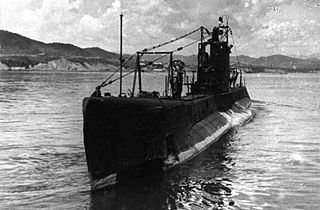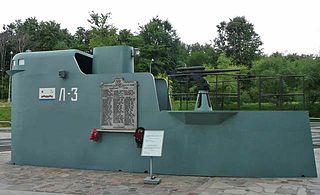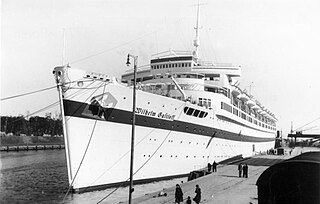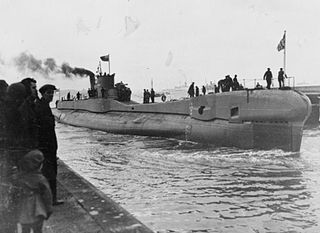
S-117 was a Soviet Shchuka-class submarine.

The Shchuka-class submarines, also referred to as Sh or Shch-class submarines, were a medium-sized class of Soviet submarines, built in large numbers and used during World War II. "Shchuka" is Russian for pike. Of this class, only two submarines entered service after 1945, although they were launched before the war.
The Black Sea Campaigns were the operations of the Axis and Soviet naval forces in the Black Sea and its coastal regions during World War II between 1941 and 1944, including in support of the land forces.
Щ-213 was a Soviet Navy Shchuka-class submarine, Type X. She was built at the Sudostroytelnyi zavod imeny 61 kommunara in Mykolaiv, Ukrainian SSR, and entered service in October 1938 with the Soviet Black Sea fleet.
Щ-215 was a Soviet Navy Shchuka-class submarine, Type X. She was built at the Sudostroytelnyi zavod imeny 61 kommunara in Mykolaiv, Ukrainian SSR, and entered service in October 1938 with the Soviet Black Sea fleet based at Sevastopol. Shch-215 survived the Second World War, was reclassified С-215 in 1949 and was decommissioned in 1955.
Shch-317 was a Shchuka-class submarine of the Soviet Navy. Her keel was laid down by A. Marti in Leningrad on 23 July 1934. She was launched on 24 September 1935 and commissioned on 29 September 1936 in the Baltic Fleet.
Shch-214 was a Shchuka-class submarine of the Soviet Navy. Her keel was laid down by 61 Kommunara in Nikolajev on 13 July 1935. She was launched on 23 April 1937 and commissioned on 4 March 1939 in the Black Sea Fleet. The submarine was under the command of Captain Vlasov Vladimir Yakovlevich until the loss of the vessel.

Shch-307 was a Shchuka-class submarine of the Soviet Navy. Her keel was laid down by Baltiyskiy Zavod in Leningrad on 6 November 1933. She was launched on 1 August 1934 and commissioned on 4 August 1935 in the Baltic Fleet.

Submarine warfare in the Black Sea in World War II during 1941 primarily involved engagements between submarines of the Soviet Black Sea Fleet attacking Axis merchantmen defended by Romanian and Bulgarian warships. These engagements were a part of the naval Black Sea campaigns between Axis and Soviet naval forces.
The action of 6 December 1941 was a confrontation between the Bulgarian and Soviet navies in the Black Sea during World War II, taking place near the Bulgarian coast at Cape Emine.

The Soviet Navy launched the Soviet submarine Baltic Sea campaign in 1942 to harass the strategic iron-ore traffic from neutral Sweden to Nazi Germany during World War II. The Soviet Union and the German Reich fought each other on the Eastern Front (1941-1945) during the war. The Allies also launched other operations - especially involving the Royal Navy - against the traffic.

The Soviet submarine Baltic Sea campaign in 1943 was launched by the Soviet Navy to harass the strategic iron ore traffic from neutral Sweden to Nazi Germany on the Eastern Front during the WWII. Other operations were launched by Allies, especially by the Royal Navy. The offensive was a repetition of the previous campaign in 1942 but resulted in a failed outcome.
Submarine warfare in the Black Sea in World War II during 1942 involved engagements between primarily submarines of the Soviet Black Sea Fleet attacking Axis merchantmen defended by Romanian and German naval warships. These engagements were a part of the Black Sea campaigns between Axis and Soviet naval forces.

Submarine warfare in the Black Sea in World War II during 1943 involved engagements between submarines of the Soviet Black Sea Fleet attacking Axis merchantmen defended by Romanian and German naval warships, as well as and German U-boats attacking Soviet merchants on the eastern Black Sea. These engagements were a part of the Black Sea campaigns between Axis and Soviet naval forces.

Submarine warfare in the Black Sea in World War II during 1944 involved engagements between submarines of the Soviet Black Sea Fleet attacking Axis merchantmen, defended by Romanian and German naval warships, as well as German U-boats and Romanian submarines attacking Soviet merchants on the eastern Black Sea. Before the conclusion of the campaign, Romania joined the Allies after King Michael's Coup. These engagements were a part of the naval Black Sea campaigns.

The Soviet submarine Baltic Sea campaign in 1941 was launched by the Soviet Navy at the early stage of Operation Barbarossa. The offensive was hampered by the quick German ground advance and the retreat of Soviet naval vessels from the main Baltic harbors.

The Soviet submarine Baltic Sea campaign in 1944 was launched by the Soviet Navy to harass enemy shipping and naval military assets of the Nazi Germany on the Eastern Front during World War II.

The Soviet naval Baltic Sea campaign in 1945 was launched by the Soviet Navy to harass enemy shipping and naval military assets of Nazi Germany on the Eastern Front during World War II. Both submarines and surface units of the Soviet Navy were employed. The campaign scored successes during Operation Hannibal.

The Barents Sea campaign in 1941 was a submarine operation in the Arctic waters of the Barents Sea during World War II. It was a combined Soviet and British campaign, with boats departing from Polyarny to harass German shipping along the Norwegian coast.
Shch-421 was a Shchuka-class submarine of the Soviet Navy. She served in the Northern Fleet during World War II. She was led by commander Nikolai Lunin, before he was replaced by his second-in-command Fyodor Vidyayev.











